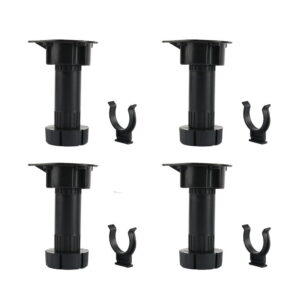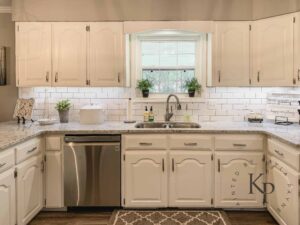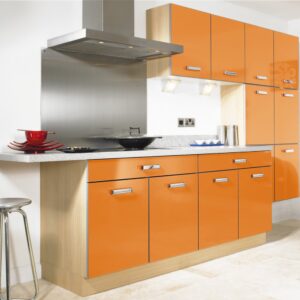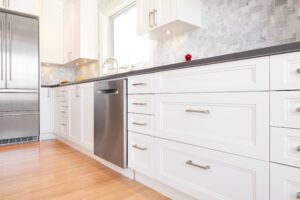Are you looking to give your kitchen a fresh new look? Adding new cabinets to your existing kitchen can be a game-changer. Not only do new cabinets provide additional storage space, but they also enhance the overall aesthetic appeal of your kitchen. Whether you’re looking to upgrade your kitchen for personal enjoyment or to increase your home’s value, this comprehensive guide will walk you through the process of adding new cabinets to your existing kitchen. From planning and design to installation and finishing touches, we’ll cover everything you need to know to transform your space.
1. Assess Your Current Kitchen
Before diving into the process of adding new cabinets, it’s essential to assess your current kitchen. Take a close look at the layout, functionality, and aesthetics of your kitchen. Identify any pain points or areas that need improvement. This evaluation will help you determine the type and style of cabinets that will best suit your needs.
Consider the following questions:
- Do you need more storage space?
- Is your current cabinet layout efficient?
- Are there any damaged or outdated cabinets that need replacement?
- What is your budget for the project?
Answering these questions will provide you with a clear understanding of your requirements and guide you in the decision-making process.
2. Set a Budget
Once you’ve assessed your current kitchen and identified your needs, it’s time to set a budget for your cabinet project. The cost of adding new cabinets can vary significantly depending on factors such as materials, size, style, and the extent of the project. It’s important to determine how much you’re willing to invest in your kitchen renovation to ensure you stay within your financial limits.
Research cabinet prices and consider additional costs such as installation, hardware, and finishing. It’s also a good idea to set aside some extra funds for unexpected expenses that may arise during the project.
3. Plan the Layout and Design
Once you have a budget in place, it’s time to plan the layout and design of your new cabinets. Start by measuring your kitchen space accurately. Consider the existing appliances, windows, and doors to ensure that the new cabinets will fit seamlessly into the room.
Next, explore different cabinet styles and materials that align with your desired aesthetic. Whether you prefer classic, modern, or contemporary designs, there are countless options available to suit your taste. Look for inspiration in magazines, online sources, and home improvement stores to gather ideas for your new kitchen cabinets.
Consider the following factors when planning the layout and design:
- Functionality: Think about how you use your kitchen and organize your cabinets accordingly. Consider factors such as storage needs, accessibility, and workflow.
- Color and Finish: Choose a color and finish that complements your existing kitchen decor. Consider the overall theme and style you want to achieve.
- Hardware: Select hardware that matches the style of your cabinets. Handles, knobs, and pulls can add a finishing touch to the overall design.
Creating a detailed plan for your new cabinets will ensure a smooth installation process and help you visualize the final result.
4. Choose the Right Cabinets
With your layout and design plan in hand, it’s time to choose the right cabinets for your kitchen. With a wide range of options available, it’s crucial to select cabinets that meet your functional and aesthetic requirements.
Consider the following factors when choosing your cabinets:
- Material: Cabinets are available in various materials, including wood, laminate, and metal. Each material has its own advantages and disadvantages, so choose one that suits your needs and budget.
- Quality: Look for cabinets that are well-constructed and durable. Quality cabinets will withstand daily use and last for many years.
- Storage Options: Consider the different storage options available, such as shelves, drawers, and dividers. Choose cabinets that provide ample storage space for your kitchen essentials.
- Customization: If you have specific requirements or unique kitchen features, consider custom cabinets that can be tailored to your needs.
Take your time to research different cabinet manufacturers and suppliers. Read reviews, compare prices, and visit showrooms to get a firsthand look at the quality and craftsmanship of the cabinets.
5. Hire a Professional or DIY?
Once you have chosen the right cabinets for your kitchen, you need to decide whether to hire a professional contractor or tackle the installation yourself. While DIY installations can save you money, it’s crucial to assess your skill level and the complexity of the project.
Consider the following factors when making your decision:
- Skills and Experience: Do you have the necessary skills and experience to install cabinets? If not, hiring a professional may be the safer option.
- Time and Effort: Installing cabinets can be a time-consuming and labor-intensive task. If you’re short on time or prefer to leave it to the experts, hiring a professional is the way to go.
- Budget: Assess the cost of hiring a professional contractor versus the savings of a DIY installation. Consider the potential risks and expenses that may arise from an improper installation.
If you decide to hire a professional, do thorough research and choose a reputable contractor with experience in kitchen cabinet installations. Obtain multiple quotes, check references, and ask for examples of their previous work.
6. Preparing for Installation
Before the installation process begins, there are a few essential steps you need to take to ensure a smooth and successful project. These steps include:
- Clear the Space: Remove all items from your existing cabinets and clear the kitchen area. This will provide a clean and clutter-free space for the installation.
- Protect Your Floors and Countertops: Lay protective coverings over your floors and countertops to prevent any damage during the installation process.
- Disconnect Utilities: If necessary, disconnect utilities such as water and gas lines to ensure safety during the installation.
- Remove Existing Cabinets: If you’re replacing your existing cabinets, carefully remove them without causing any damage to the walls or surrounding areas. Dispose of the old cabinets responsibly.
By completing these preparatory steps, you’ll create an ideal environment for a smooth installation process.
7. Cabinet Installation Process
The installation process can vary depending on the type of cabinets and your kitchen’s layout. However, the following steps provide a general overview of the cabinet installation process:
- Begin with Upper Cabinets: Start by installing the upper cabinets first. Use a level to ensure that the cabinets are straight and level.
- Secure Cabinets to the Wall: Once the upper cabinets are in place, secure them to the wall using screws and brackets. Make sure they are securely attached to prevent any accidents.
- Install Base Cabinets: Install the base cabinets next, following the same process as the upper cabinets. Check for levelness and adjust as needed.
- Connect Cabinets Together: If you have multiple cabinets, connect them together using screws or connectors. This will create a seamless look and provide additional stability.
- Install Cabinet Hardware: Once the cabinets are in place, install the hardware such as handles, knobs, and pulls. This step adds the finishing touches to your new cabinets.
It’s important to follow the manufacturer’s instructions and seek professional guidance if needed during the installation process. Pay attention to details and ensure that all cabinets are securely installed.
8. Finishing Touches
After the cabinets are installed, it’s time to add the finishing touches to complete your kitchen transformation. These finishing touches include:
- Countertops: Install new countertops that complement your cabinets and enhance the overall look of your kitchen.
- Backsplash: Consider adding a backsplash to protect your walls and add a decorative element to your kitchen.
- Lighting: Install proper lighting fixtures to brighten up your kitchen and highlight your new cabinets.
- Paint or Wallpaper: Consider repainting or adding wallpaper to your kitchen walls to create a cohesive and stylish look.
These finishing touches will tie together your new cabinets and create a cohesive and visually appealing space.
Conclusion
Adding new cabinets to your existing kitchen is a transformative process that can enhance both the functionality and aesthetics of your space. By assessing your current kitchen, setting a budget, planning the layout and design, choosing the right cabinets, and following the installation process, you can achieve a kitchen that is both beautiful and functional. Whether you decide to hire a professional or tackle the installation yourself, careful planning and attention to detail will ensure a successful kitchen renovation. With the right cabinets and finishing touches, you can create a kitchen that you’ll love for years to come.
FAQs (Frequently Asked Questions)
1. How long does it take to add new cabinets to an existing kitchen?
The duration of adding newcabinets to an existing kitchen can vary depending on the size of the project and the complexity of the installation. On average, the process can take anywhere from a few days to a few weeks. Factors such as the number of cabinets, any customizations required, and the availability of contractors can also impact the timeline. It’s important to discuss the timeline with your contractor or plan accordingly if you’re doing a DIY installation.
2. Can I add new cabinets to my existing kitchen without replacing the old ones?
Yes, it is possible to add new cabinets to your existing kitchen without replacing the old ones. This option is often referred to as a “cabinet refacing” or “cabinet retrofit” project. In this process, the existing cabinet boxes are retained, while the doors, drawer fronts, and hardware are replaced. This can be a cost-effective way to give your kitchen a fresh look without the need for a complete overhaul. However, it’s important to note that cabinet refacing may not be suitable if your existing cabinets are damaged or in poor condition.
3. Should I hire a professional for cabinet installation?
The decision to hire a professional for cabinet installation depends on your skill level, the complexity of the project, and your comfort level with DIY tasks. While DIY installations can save you money, it’s important to consider the potential risks and challenges involved. Installing cabinets requires precision and attention to detail to ensure they are level, securely attached, and properly aligned. If you have limited experience with carpentry or lack the necessary tools, hiring a professional contractor can provide peace of mind and ensure a high-quality installation. Additionally, professionals often have access to trade discounts and can provide valuable advice on design and layout.
4. How much does it cost to add new cabinets to an existing kitchen?
The cost of adding new cabinets to an existing kitchen can vary significantly depending on several factors, including the size of the kitchen, the material and quality of the cabinets, any customizations required, and the location. On average, homeowners can expect to spend anywhere from $5,000 to $20,000 or more for a complete cabinet installation. It’s important to set a budget and obtain multiple quotes from reputable contractors or suppliers to get an accurate estimate for your specific project. Keep in mind that additional costs for installation, hardware, countertops, and other finishing touches should also be considered.
5. How can I maximize storage space when adding new cabinets to my kitchen?
When adding new cabinets to your kitchen, maximizing storage space is a common goal. Here are some tips to help you make the most of your cabinet space:
- Opt for full-height cabinets: Full-height cabinets extend from the floor to the ceiling, providing maximum storage space.
- Incorporate pull-out shelves or drawers: Pull-out shelves or drawers make it easier to access items at the back of the cabinet and maximize storage capacity.
- Consider deep drawers: Deep drawers are great for storing pots, pans, and larger items that may not fit well in traditional cabinets.
- Use vertical dividers: Vertical dividers can be installed in cabinets to separate baking sheets, cutting boards, and trays, making them easier to organize and access.
- Install a pantry cabinet: If space allows, consider adding a pantry cabinet to store dry goods, small appliances, and other kitchen essentials.
By incorporating these storage solutions into your new cabinet design, you can make the most of your kitchen space and keep everything organized and easily accessible.
Summary
Adding new cabinets to your existing kitchen is an excellent way to transform the space and give it a fresh new look. By assessing your current kitchen, setting a budget, planning the layout and design, choosing the right cabinets, and following the installation process, you can create a kitchen that is both functional and aesthetically pleasing. Whether you decide to hire a professional or take on the installation yourself, careful planning and attention to detail are key. Remember to consider factors such as storage space, materials, and customization options when choosing your cabinets. With the right cabinets and finishing touches, your kitchen will become a beautiful and inviting space where you can enjoy cooking and entertaining for years to come.





